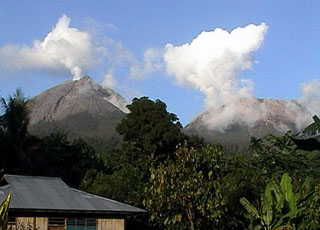Report on Lewotobi (Indonesia) — 13 November-19 November 2024
Smithsonian Institution / US Geological Survey
Weekly Volcanic Activity Report, 13 November-19 November 2024
Managing Editor: Sally Sennert.
Please cite this report as:
Global Volcanism Program, 2024. Report on Lewotobi (Indonesia) (Sennert, S, ed.). Weekly Volcanic Activity Report, 13 November-19 November 2024. Smithsonian Institution and US Geological Survey.
Lewotobi
Indonesia
8.542°S, 122.775°E; summit elev. 1703 m
All times are local (unless otherwise noted)
The Pusat Vulkanologi dan Mitigasi Bencana Geologi (PVMBG) reported that eruptive activity at Lewotobi Laki-laki remained at a high-level during 13-19 November, producing ash plumes, lava fountaining, and an advancing lava flow on the W flank, and continued to impact residents and transportation. Daily white-and-gray ash plumes rose as high as 2.5 km above the summit and drifted SW, W, and NW. According to the Darwin VAAC ash plumes rose 2.4-4.6 km (8,000-15,000 ft) a.s.l. during 13-16 November, or with maximum above-summit heights of 2.9 km on 13 November and 2.6 km during 14-16 November.
Webcam images captured during dark hours throughout the week often showed summit incandescence. A webcam image from 0013 on 15 November captured either tall lava fountaining or the explosion of incandescent material high above the summit, and incandescent material descending the upper flanks. A webcam image from 0018 on 17 November showed areas of incandescence on the distal part of the W flank lava flow. The flow advance towards Klatanlo Village (3 km NW) based on a drone overflight later that day. According to a news article BNPB stated that residents from Klatanlo Village will not be permitted to return to their homes due to unsafe conditions and will be relocated. The village will also be prone to potential lahars. Residents were prohibited within a radius of 7 km from the center of Laki-laki, though on 18 November the extended zone on the SW, W, and NW flanks was reduced to 8 km. Loud rumbling was reported on 19 November.
News articles noted that multiple domestic and international flights in and out of Lombok Airport were cancelled or rerouted on 13 November mainly due to ash from the 9-km-high ash plume produced on 12 November. The Komodo International Airport (313 km W), Frans Xavier Seda Airport (252 km W), H. Hasan Aroeboesman Airport (126 km WSW), and the Soa Airport (190 km W) remained closed, and tourists and residents continued to be moved to other islands by boat. On 14 November the Gusti Ngurah Rai International Airport (840 km W) cancelled 41 domestic and international flights. As of 2000 on 15 November a total of 6,388 evacuees remained in evacuation shelters across six locations. By 18 November almost all airports had returned to normal operations; the Frans Xavier Seda Airport remained closed.
Geological Summary. The Lewotobi edifice in eastern Flores Island is composed of the two adjacent Lewotobi Laki-laki and Lewotobi Perempuan stratovolcanoes (the "husband and wife"). Their summits are less than 2 km apart along a NW-SE line. The conical Laki-laki to the NW has been frequently active during the 19th and 20th centuries, while the taller and broader Perempuan has had observed eruptions in 1921 and 1935. Small lava domes have grown during the 20th century in both of the summit craters, which are open to the north. A prominent cone, Iliwokar, occurs on the E flank of Perampuan.
Sources: Pusat Vulkanologi dan Mitigasi Bencana Geologi (PVMBG, also known as CVGHM), Antara News, Antara News, Antara News, Antara News, Antara News, Antara News, Antara News, Antara News

